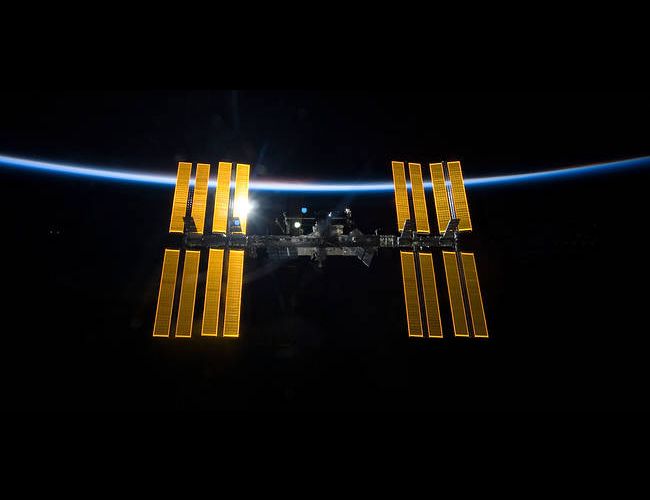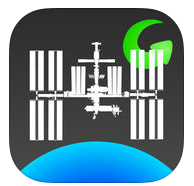Tutorial: How to photograph an International Space Station fly-by

Image courtesy of Nasa
We'll cover the everything from the equipment you will need to planning, the shoot and post processing the results. So let's dive straight in and start off with the equipment you are going to need:
Equipment
Camera
Tripod
Remote trigger release
Some ND grad filters (optional)
Planning
The first thing you need to do is find out where and when the ISS is going to pass overhead. Because the ISS is a satellite of sorts, it streaks across the sky as a bright white dot just like other satellites do. So this will be like shooting star trails.
There are several apps you can use to determine when and where and with the better apps they will even tell you the direction. I used GoISSWatch on the iPhone.

Take a note of all the times the ISS will fly over your chosen location and plan to be there on every one of those occasions. If you life somewhere with unpredictable weather like I do here in Scotland, then you need to take every opportunity you can get. The last thing you need is cloud cover ruining your shot.
The Shoot
I recommend getting to your chosen location a good 30 minutes before you expect the ISS to pass over. This will give you time to setup and frame your composition and make some test shots. This part is critical because you are only getting one chance. Like with any astrophotography you should go to the highest f-stop your camera lens will allow. Mine was f/4.5 but if you can go as low as 2.8 that would be super.
You want to avoid causing the stars to turn into trails so stay below the 500 rule. So if you are using a 24mm lens you divide 500 by 24 (500/24 = 21), which gives 21 so you need to keep your exposure under 21 seconds to avoid trails. That’s fine as 20 seconds will give the ISS enough time to give you a decent trail into your shot.
Complicating Matters
So if you are like me and you don’t want to take a shot of a streak of light in the sky with nothing else in it but sky or a field in the middle of nowhere then it gets a little more complicated. I wanted a shot that incorporated the city I live in. That means dealing with a lot of light pollution. How will I keep the light from the city under control and still expose long enough to get the ISS trail?
My solution was to take to ND Grad filters (0.6 and a 0.2), stacked them and then turned them upside down so they were making the bottom half of the image darker instead of the sky. Then I tweaked my settings so I could get a decently long enough exposure to still get the ISS in.
In the end I took 10 exposures at f/4.5, 9sec ISO 800 @47mm.

You can see here by the areas circled in red that each one the pics has a small part of the trail. These will need to be combined in Photoshop later.
Post Processing
For this section I am assuming you are already familiar with lightroom and photoshop. Each of these 10 exposures has a small bit of the ISS moving across the sky, so I would need to combine them to get one long trail.
I imported them to lightroom and cleaned up the color balance, and fiddled the highlights and shadows to balance the image further and get the light trail to stand out a bit more. I duplicated these adjustments precisely on all the images which can be easily done with lightroom’s sync feature.
Then onwards to photoshop! Here I stacked and auto-aligned the images using a standard photoshop script and then blended them together with ‘lighten’ blend mode. You will get spaces between each trail so you need to just take bits of existing trail to fit them together to get one smooth seamless line. I highly recommend experimenting here to get the look you are after.
The Result

Thanks for Looking.
Follow me and read more of my posts here: @fiftysixnorth
Don't forget to Upvote and Resteem
Thanks this is a great Tutorial very clear and easy to follow
Tip!
Thanks man! I'm glad you liked it :)
Wow this a great tutorial. I will definitely be shooting the ISS on the next clear night. If I can get any images worthy of showing I will put them in here... Don't hold your breathe ;)
Thanks again for sharing. upvoted and following.
Cheers,
buckydurddle
Thanks @buckydurddle! I'm glad you liked the tutorial. I'd love to see any photos you capture of the ISS. Thanks for the upvote and follow :)
Great post,thanks for explaining how to do that,you make it sound so easy.Love the end product,what an amazing photo.
Thanks for sharing.
Thanks! Let me know if you ever give it a try yourself. I would love to see the results! :)
This post recieved a vote from @minnowpond. For more information click https://steemit.com/steemit/@minnowpond/boost-your-rewards-with-minnowpond
Wow, it was a lot of preparation :) And it takes knowledge and patience too :) But you have got yourself an amazing shot mate :) Good work :)
Thanks very much :) It was very rewarding!
Wow that was
thanks :)
Hi @fiftysixnorth! @tattoodjay is sending you 0.1 SBD tip and @tipU upvote :)
:)
@tipU quick guide | earn interest in @tipU profit
Thank you so much @tattoodjay :)
Awesome shot of Edinburgh and a great tutorial. Worth Resteeming so that I can find it again. By the way, I am airborne on the first leg of my trip to Scotland!
Thanks! And have a great trip! :)
Very good tutorial and the result is breathtaking, I'm wondering if we can get any details of the ISS using a telephoto lens and a high resolution sensor to be able to crop the image ?
Thanks very much! And to answer your question, yes you can! :) You need a telescope though, a telephoto wouldn't cut it. You'd need a focal length of at least 800mm. Then you need to hook up a DSLR and a trigger release. A telescope wont track the ISS as it moves to fast so you have to follow it manually. Its really tough! I don't have the prerequisite gear so I've never tried it :)
Magnificent photo!!
Thank you! :)